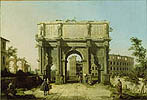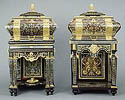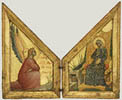


These activities are designed to take place in the galleries of the Museum at the Getty Center. Use them when you bring your class for a Self-Guided Visit.
|
 |

|
 |
 |
Activities 1–10 of 10 |
 |
 |
 |
 |
 |

  |
 |
My Getty Vacation Travel Log—A Set of 6 Activities
Grades/Level: Lower Elementary (K–2), Upper Elementary (3–5)
Subjects: Visual Arts, English—Language Arts
Activity Overview: Take your students on an imaginary vacation at the J. Paul Getty Museum at the Getty Center. Six activities allow students to visit various places, meet a variety of people, and take home a souvenir. They will practice writing about, observing, and sketching works of art.
|
 |
 |
 |
Meet the Children of the Getty—A Set of 8 Activities
Grades/Level: Lower Elementary (K–2)
Subjects: Visual Arts
Activity Overview: Introduce your students to the many children represented in artworks at the J. Paul Getty Museum at the Getty Center. Eight activities allow students to make connections between their own lives and the lives of children from other places and time periods. Drawing, writing, and discussion activities encourage students to slow down, look closely, and think about what they see.
|
 |
 |
 |
Art as Artifact—A Set of 5 Activities
Grades/Level: Middle School (6–8), High School (9–12)
Subjects: Visual Arts
Activity Overview: Students search art objects at the Getty Center in these five detective activities for clues about the people in the past who used them and the world in which they lived.
|
 |
 |
 |
Portraits of Power—A Set of 6 Activities
Grades/Level: High School (9–12)
Subjects: Visual Arts
Activity Overview: The activities in this self-guided tour of the Museum at the Getty Center explore different aspects of the idea of power and how artists have represented and been inspired by this idea for hundreds of years.
|
 |
 |
 |
Interview With...
Grades/Level: Lower Elementary (K–2), Upper Elementary (3–5)
Subjects: Visual Arts
Activity Overview: A personal history can be imagined and re-created by looking carefully at a portrait. Students carefully study a portrait and connect its visual components with contemporary understandings of people and their attributes.
|
 |
 |
 |
Thirty-Second Look—Getty Center
Grades/Level: Lower Elementary (K–2), Upper Elementary (3–5), Middle School (6–8), High School (9–12)
Subjects: Visual Arts
Activity Overview: Researchers in museums have found that 30 seconds is the average amount of time visitors spend in front of works of art. After looking at a work of art for only 30 seconds, students will use their visual recall to discuss what they noticed in order to demonstrate that really seeing and reflecting on a work of art requires time.
|
 |
 |
 |
Looking at People in Portraits
Grades/Level: Lower Elementary (K–2), Upper Elementary (3–5), Middle School (6–8), High School (9–12)
Subjects: Visual Arts
Activity Overview: Students look at two portraits in the Museum at the Getty Center and think about the techniques an artist uses to tell us about the character of their subject.
|
 |
 |
 |
Seeing the Invisible: Angels and Demons
Grades/Level: Upper Elementary (3–5), Middle School (6–8), High School (9–12)
Subjects: Visual Arts
Activity Overview: Students search for angels and demons within the paintings in the Medieval and Renaissance galleries at the Getty Center. They examine the ways that artists made these invisible creatures visible.
|
 |
 |
 |
Making Furniture That's Fit for a King
Grades/Level: Middle School (6–8), High School (9–12)
Subjects: Visual Arts
Activity Overview: Students learn about the furniture made in the 1600s and 1700s for wealthy Parisians and the King of France.
|
 |
 |
 |
Create Your Own Gallery Lesson for the Getty Center
Grades/Level: Lower Elementary (K–2), Upper Elementary (3–5), Middle School (6–8), High School (9–12)
Subjects: Visual Arts, English—Language Arts, History—Social Science, Science, Mathematics
Activity Overview: You can create your own lesson for your visit to the Museum at the Getty Center. Use the artworks at the Getty to teach subjects you are already covering in your classroom. Included are some tips on teaching in the Museum and engaging your students with art objects.
|
 |
![]() |
 |
 |
 |
 |
Activities 1–10 of 10 |
 |
 |
 |
 |
 |

  |
 |








